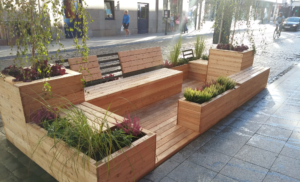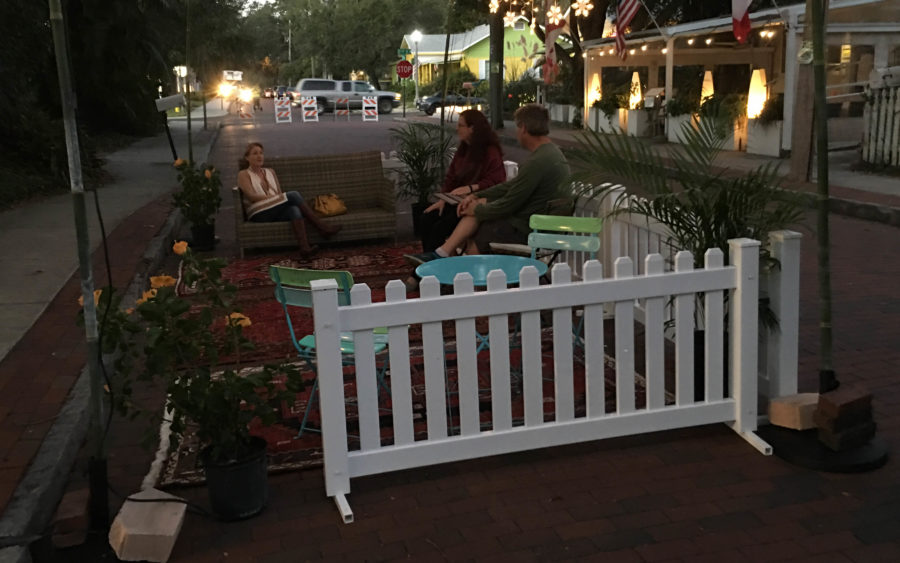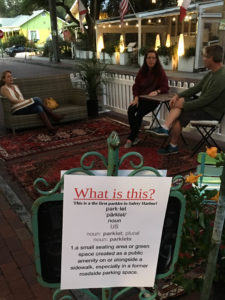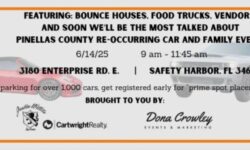Safety Harbor officials seek public input on proposed parklet program


Back in October, the Safety Harbor City Commission agreed to have city staff create an ordinance allowing parklets, or temporary sidewalk extensions, on Main Street based on a recommendation by the Planning and Zoning board.
After meeting with several department heads and reviewing the policies of other pilot parklet cities, including Charlotte, Ft. Lauderdale, Jacksonville and Miami, City Manager Matt Spoor presented a draft manual for a pilot parklet program to the commission on Monday night.
According to the terms of the proposal, one parklet per block—with a maximum of three to start—would be allowed in certain spaces downtown, with restrictions based on proximity to intersections, driveways and other conditions.
Any individual, group or business would be eligible to apply for a parklet, provided they agree to the terms and conditions and pay a $300 application fee. The parklet would have to be approved by 75 percent of business owners on the block, and the permit would last for two years, at which time the applicant could apply to renew the agreement at a cost of $150.00
While all five local lawmakers said they were in favor of bringing a parklet program to town, several expressed reservations about certain aspects of the proposal, including the locations, the prohibitive cost involved and the potential for the program to fail before the initial two-year permit period expired.

“I like the concept, but I can see the potential for conflict in the future,” Commissioner Andy Zodrow said of the condition that would allow anyone who qualified to put a parklet in front of any eligible storefront in town.
“This is like (a business owner) parking in front of a storefront on steroids.”
Spoor noted under the terms of the program, that couldn’t happen, since 75 percent of the merchants on the proposed parklet block would have to sign-off on the feature.
“The parklet is for the public,” Spoor said and they are not meant to be an extension of the business.
According to the terms of the proposal, no food, beverages or merchandise could be sold on the parklet, though guests could eat and drink there if the corresponding establishment allows food and alcohol sales.
Zodrow’s colleagues also expressed concerns with the proposal.

Mayor Joe Ayoub quested what would happen “if there is a big backlash” to the project after six months, while Commissioner Scott Long stated that based on the cost to produce the parklets—estimated at $10,000-$20,000—only one or two business owners in the downtown district would be interested in investing in one.
“I think it’s a great idea, but I don’t know why anyone would want to put one in front of a business other than their own business,” Long said.
Indeed, when Ayoub asked who he believed might be interested in pursuing a parklet permit, Spoor replied, “bars and restaurants on Main Street.”
One downtown business owner already utilized a scaled-down version of a parklet to help promote her business, although she’s not located on Main Street and she doesn’t own a bar or restaurant.
Melissa Haist, an artist and owner of the boutique, Tupelo on 4th, put a temporary parklet in front of her shop during Third Friday in November, and she agreed with Spoor that the feature is supposed to be for the benefit of the public.
“A parklet is like a park in the street—it’s a common area open to everybody,” Haist told Safety Harbor Connect Tuesday.

“They initially started as a way to get rid of excess pavement in the cities by covering parking spaces with inviting green spaces. They were not intended to be a temporary extension of someone’s business. That’s not what they’re for.”
Haist said her parklet came together suddenly after a few fellow merchants heard about the P&Z plan, and despite spending a little over $100 on the materials, she said the feature was a huge hit.

“People just gathered in it,” she said.
“People who were going to eat at Pizzeria Gregorio and Parts of Paris enjoyed it. They drank and chatted and enjoyed the surroundings. It was exactly the way it was supposed to be utilized—a place for everybody, a common area, not an extension of Tupelo.”
After discussing the pilot parklet program for about an hour, the commissioners directed Spoor to gather more input from the public and bring the results back to them at a future meeting.
“We’re going to ask for feedback through a dedicated email address—parklets@cityofsafetyharbor.com—and then we’ll take the feedback until we discuss it with the commission again, probably sometime in April,” Spoor said by phone Wednesday.
He stressed that while Haist’s parklet was a stripped-down, basic version, off Main Street, that would not be affected under the pilot program, he agreed with her belief of how the parklets are intended to be utilized.
“The idea is it’s an extension of the sidewalk, somewhere the public can gather and hang out,” he said, adding, “under the terms of the policy, people can get creative with them. It’s not ‘one-size-fits-all.’
“I think, if this gets approved, people are going to love them.”
How do you feel about parklets, Harborites? Let us know in the comments below or on the Safety Harbor Connect Facebook page.
Related content:





Parklets—what a great idea! . Safety Harbor: “#1 downtown in Tampa Bay”. One wonderful step closer to permanently closing off Main Street from 5th to Bayshore as a pedestrian mall. Secondly, why not close off 3rd and 4th streets north and south of Main during food-related downtown festivals—and put tables on these side streets to help visitors holding a glass of wine and a plate of food find a place to sit and eat, away from the jostling mob on Main? Establish a volunteer “SideStreetCrew” to monitor, bus tables and assist our visitors. Great temporary add-on to parklets.
Vibrant cities such as San Francisco, Phoenix, Philadelphia, Oakland, Los Angeles, San Jose, Dallas, Seattle, San Diego, and Vancouver have all successfully installed parklets. These parklets have benefited local businesses, residents, and visitors by providing unique public spaces that attract customers and foster community conversation. Yes, let’s install these beneficial parklets in Safety Harbor!
I think it has the potential of making the downtown even more shopper-friendly. What if the parklet was built on a sled of 4×4’s and once a month it was pulled or pushed to the next adjoining parking space? This way it wouldn’t favor a business or hamper one business’s parking spot for two years because it would rotate between spaces. Do one for each side of the street as an experiment as it would just slide down one spot each month, and then start back the other way. That way it wouldn’t be an extension of someone’s business, but a roving city mini-park. > To make it a truly viable area to sit, you might need to include umbrellas similar to the ones on the sidewalks in downtown St. Petersburg – as the tables with umbrellas anywhere you go are the ones people sit at first.
I, too, love the idea of a few parklets on Main Street. More so than serving as green space, parklets are extensions of the sidewalk. This could really help with several pinch points on Main Street where cafe tables narrow the walkway to single file. This makes for a less pleasant stroll, especially with a baby stroller or a pooch or when holding hands. The ideal minimum sidewalk width for a Main Street like ours is 20 feet. There are few locations anywhere in downtown where sidewalks are greater than 10 feet. Sidewalk cafes and pedestrians on sidewalks make a downtown come alive! A parked car, not so much. Some may feel that parking in downtown is a challenge but isn’t that only during events when Main Street is closed to car traffic? If so, one or two parklets taking up one or two parking space shouldn’t be an issue. P.S. I have never had a problem finding parking in DT that I haven’t experienced at Publix. At either place, I never expect to find a parking space 100 feet from the door. It’s all how you look at it, right?
I love the concept, and think it would be draw to already aspiring downtown area.
It looks appealing but i fear too much is left to owners’ interpretation. If they impede access to the sidewalk they may become an annoyance to shoppers. They are apt to attract kids loitering. We need more viable goods and services downtown, as we have a great deal of pretty greenspace around.